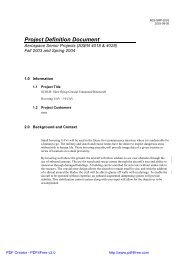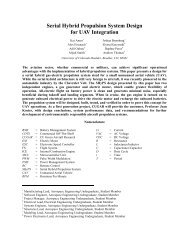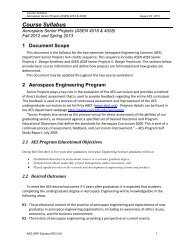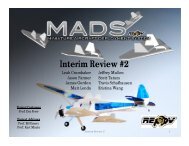PFR - Aerospace Engineering Sciences Senior Design Projects ...
PFR - Aerospace Engineering Sciences Senior Design Projects ...
PFR - Aerospace Engineering Sciences Senior Design Projects ...
You also want an ePaper? Increase the reach of your titles
YUMPU automatically turns print PDFs into web optimized ePapers that Google loves.
Project Final Report – CUDBF April 30 th , 2009<br />
ASEN 4028: <strong>Aerospace</strong> <strong>Senior</strong> <strong>Projects</strong><br />
10.0 Software <strong>Design</strong> Elements<br />
Author: Brett Miller<br />
Co-Author: Mark Findley, Jarryd Allison<br />
The Buff-2 Bomber had two main software components. The first allowed the team to iterate<br />
their wing design in order to optimize the aircraft’s wing geometry. The second controlled the<br />
aircraft’s payload through the microcontroller. These two components detailed in the following<br />
sections below.<br />
10.1 Aerodynamic <strong>Design</strong> Software<br />
The aerodynamics sub-team focused on minimizing weight, configuring the aircraft to be able to<br />
fit within the dimensions of the storage container, and most importantly being able to fly all<br />
missions. It was important to choose a geometry without negatively affecting the stability of the<br />
aircraft. Therefore, analysis was performed to select the optimal geometry configuration, while<br />
still adhering to project requirements.<br />
First the airfoil was selected, and the program XFOIL was used to determine certain airfoil<br />
properties such as lift characteristics, drag, and the moment coefficients. Flying wing airfoils<br />
documented in the University of Illinois, Urbana-Champaign airfoil database were assessed<br />
along with the Osborne <strong>Design</strong>/Build/Fly airfoil collection. From this collection, the drag polars<br />
were used to select the airfoils to be used.<br />
Figure 88: Airfoil Selection Flow Diagram<br />
To analyze the effect on static margin for a given center of gravity location with varying leading<br />
edge sweep angle and taper ratio, MATLAB code was then created to iterate between many<br />
different geometries at once, and output files that were compatible with AVL. The output<br />
geometries from MATLAB were run through the AutoIT program which entered the geometries<br />
along with commands into AVL. This process yielded the stability derivatives for every<br />
combination produced in the MATLAB iteration, and these stability derivatives were then reentered<br />
into a different MATLAB code to determine the static margin of the selected geometry.<br />
This MATLAB code stored the different sweep, taper, and static margin values, and the results<br />
plotted in order to observe how sweep and taper affect the static margin. In this way, the ideal<br />
static margin and final geometry of the Buff-2 Bomber was selected. Figure 89 shows this flow<br />
diagram.<br />
112
















